Networking Backbone - EN 50121 Railway Communication Network for Mainline Signaling and Train Control Applications
EN 50121 Railway Communication Network for Mainline Signaling and Train Control Applications
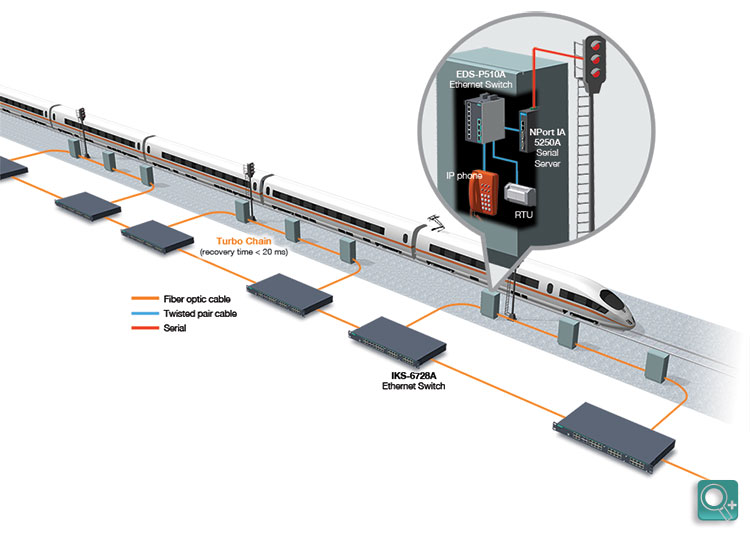
EN 50121 Railway Communication Network for Mainline Signaling and Train Control Applications
Today´s railway infrastructure must shoulder greater demands driven by increasing inter-city and inter-state traffic. Growing urbanization has increased the number of passengers that rely on metropolitan rail systems, and increased economic activity at industrial facilities, mines, and ports now tax the transportation mainline. Ideally, a railway system should meet growing capacity requirements while still leveraging existing infrastructure and not compromising on safety and security. Thanks to advancements in automated signaling and train control systems, this is now possible.

Moxa EN 50121 Railway Communication Solutions
Layer 3 Wayside Ethernet Switches for Vital and Non-Vital Network Segregation
Railway communication networks need a solution that will avoid any potential interference in the transmission of critical data. For example, railway operations would grind to a halt if a virus infection and broadcast storm were to shut down the communications network. Moxa?s ICS and IKS series solutions are Ethernet switches specifically designed for wayside applications. It is EN-50121-4 compliant and can operate in temperature extremes of -40 to 75°C. The IKS-G6824 Layer 3 Ethernet switch is especially useful for segregating larger networks.
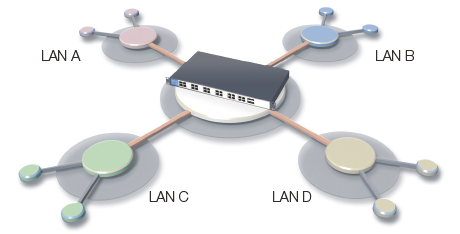
An Industrial-Grade NMS for Easier Wayside Network Management
A NMS is important for managing and monitoring network devices. A wayside railway communication network will include Ethernet switches, terminal servers and other network devices such as interlocking controllers. MXview is a Moxa-exclusive industrial NMS that was specifically designed from the ground up to meet the needs of industrial and railway communications networks, not enterprise office networks. Its feature portfolio meets all of the requirements outlined below.
A Reliable Fiber Backbone with Fast Self-Healing Functionality for Large-scale Networks
Wayside data packets need to travel long distances because the depots and stations of a mainline transportation grid typically cover a wide physical area; the distance between two depots could be anything from a hundred meters to many kilometers. Moxa´s wide portfolio of Ethernet switches includes the rack-mount PT-7000, IKS-6000 series, and the DIN-rail mounted EDS-400A, 500A, and 600 series, all of which possess available multi-mode, single-mode, and long-haul design fiber ports. They also support Turbo Ring? network redundancy technology that excels in mainline signaling and control communications because it delivers excellent convergence time on large-scale networks. Even in a large network of up to 250 nodes, network recovery can be achieved within 20 ms.
In addition, Moxa also offers optical fiber-to-Ethernet converters, the IMC-101 and PTC-101 series, which are excellent complements for the Ethernet switches. These complete solutions have rugged wide operating temperature range of -40 to 75/85°C and high EMC/EMI resistance. The new PTC-101-M12 Ethernet-to-fiber media converters convert from 10/100BaseT(X) to 100BaseFX. The models are available with SC/ST connectors in fiber and M12 connector in Ethernet to provide a reliable communications link. The PTC-101-M12 is compliant with EN 50121-4 and excels in the high-vibration wayside environment of railway applications.
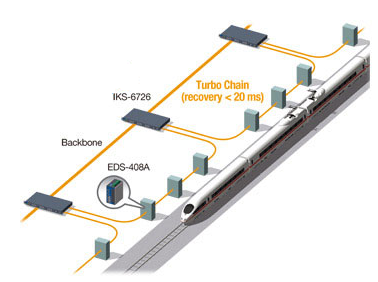
Turbo Chain Enables Resilient and Flexible Network Expansion
Once a network is up and running and fulfilling all the other requirements of railway operations, it can become difficult to expand without severe disruption. Moxa´s Turbo Chain technology is an evolution of Turbo Ring which provides a complementary solution that can easily create network expansions which seamlessly integrate and interoperate with any existing network without compromising redundancy. Turbo Chain works with any network architecture, such as a SONET/SDH telecom network or the RSTP/STP networks that are common in OCC (operation control center) and larger yards.
The beauty of Turbo Chain is that it can attach (hook) the expansion onto any existing network, while still maintaining strong convergence time when a network node or link goes down.
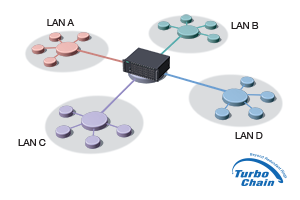
Robust Connectivity with Legacy Devices
Even as railway communication networks embrace new, more reliable, and more convenient communications technologies, operators still need to connect with legacy devices such as interlocking controllers, axle counters, and switchable balises. These devices typically use a RS232 or RS422/485 communications interface, either for configuration, diagnosis, or data transmission purposes. Moxa NPort IA5000AI series serial device servers include 1, 2, or 4 isolated serial ports featuring wide temperature from -40 to 75°C for severe operating environments. The NPort S8000 series is a specially designed terminal server with 4 isolated serial ports, and 5/8 Ethernet ports. As a terminal server it has all of the managed features of Moxa Ethernet switches, such as Turbo Ring, Turbo Chain, LLDP, and VLAN for higher network availability and better management purposes. The latest NPort 5000AI-M12 is compliant with EN 50121-4 and essential sections of EN 50155, covering operating temperature, power input voltage, surge, ESD, and vibration, making them suitable for rolling stock and wayside applications where high levels of vibration exist in the operating environment.
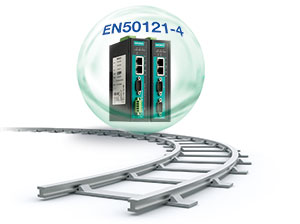
Today´s railway infrastructure must shoulder greater demands driven by increasing inter-city and inter-state traffic. Growing urbanization has increased the number of passengers that rely on metropolitan rail systems, and increased economic activity at industrial facilities, mines, and ports now tax the transportation mainline. Ideally, a railway system should meet growing capacity requirements while still leveraging existing infrastructure and not compromising on safety and security. Thanks to advancements in automated signaling and train control systems, this is now possible.

Moxa EN 50121 Railway Communication Solutions
Layer 3 Wayside Ethernet Switches for Vital and Non-Vital Network Segregation
Railway communication networks need a solution that will avoid any potential interference in the transmission of critical data. For example, railway operations would grind to a halt if a virus infection and broadcast storm were to shut down the communications network. Moxa?s ICS and IKS series solutions are Ethernet switches specifically designed for wayside applications. It is EN-50121-4 compliant and can operate in temperature extremes of -40 to 75°C. The IKS-G6824 Layer 3 Ethernet switch is especially useful for segregating larger networks.

An Industrial-Grade NMS for Easier Wayside Network Management
A NMS is important for managing and monitoring network devices. A wayside railway communication network will include Ethernet switches, terminal servers and other network devices such as interlocking controllers. MXview is a Moxa-exclusive industrial NMS that was specifically designed from the ground up to meet the needs of industrial and railway communications networks, not enterprise office networks. Its feature portfolio meets all of the requirements outlined below.
- Automatic topology discovery via LLDP
- Real-time link status & traffic statistics
- Real-time alarm via SNMP Trap or SNMP Inform
- Network reporting functions
- Support for large networks (2000 nodes)
- Displays a diverse range of devices used in railway networks (through MIB compiler)
- Visualized Virtual LAN
A Reliable Fiber Backbone with Fast Self-Healing Functionality for Large-scale Networks
Wayside data packets need to travel long distances because the depots and stations of a mainline transportation grid typically cover a wide physical area; the distance between two depots could be anything from a hundred meters to many kilometers. Moxa´s wide portfolio of Ethernet switches includes the rack-mount PT-7000, IKS-6000 series, and the DIN-rail mounted EDS-400A, 500A, and 600 series, all of which possess available multi-mode, single-mode, and long-haul design fiber ports. They also support Turbo Ring? network redundancy technology that excels in mainline signaling and control communications because it delivers excellent convergence time on large-scale networks. Even in a large network of up to 250 nodes, network recovery can be achieved within 20 ms.
In addition, Moxa also offers optical fiber-to-Ethernet converters, the IMC-101 and PTC-101 series, which are excellent complements for the Ethernet switches. These complete solutions have rugged wide operating temperature range of -40 to 75/85°C and high EMC/EMI resistance. The new PTC-101-M12 Ethernet-to-fiber media converters convert from 10/100BaseT(X) to 100BaseFX. The models are available with SC/ST connectors in fiber and M12 connector in Ethernet to provide a reliable communications link. The PTC-101-M12 is compliant with EN 50121-4 and excels in the high-vibration wayside environment of railway applications.

Turbo Chain Enables Resilient and Flexible Network Expansion
Once a network is up and running and fulfilling all the other requirements of railway operations, it can become difficult to expand without severe disruption. Moxa´s Turbo Chain technology is an evolution of Turbo Ring which provides a complementary solution that can easily create network expansions which seamlessly integrate and interoperate with any existing network without compromising redundancy. Turbo Chain works with any network architecture, such as a SONET/SDH telecom network or the RSTP/STP networks that are common in OCC (operation control center) and larger yards.
The beauty of Turbo Chain is that it can attach (hook) the expansion onto any existing network, while still maintaining strong convergence time when a network node or link goes down.

Robust Connectivity with Legacy Devices
Even as railway communication networks embrace new, more reliable, and more convenient communications technologies, operators still need to connect with legacy devices such as interlocking controllers, axle counters, and switchable balises. These devices typically use a RS232 or RS422/485 communications interface, either for configuration, diagnosis, or data transmission purposes. Moxa NPort IA5000AI series serial device servers include 1, 2, or 4 isolated serial ports featuring wide temperature from -40 to 75°C for severe operating environments. The NPort S8000 series is a specially designed terminal server with 4 isolated serial ports, and 5/8 Ethernet ports. As a terminal server it has all of the managed features of Moxa Ethernet switches, such as Turbo Ring, Turbo Chain, LLDP, and VLAN for higher network availability and better management purposes. The latest NPort 5000AI-M12 is compliant with EN 50121-4 and essential sections of EN 50155, covering operating temperature, power input voltage, surge, ESD, and vibration, making them suitable for rolling stock and wayside applications where high levels of vibration exist in the operating environment.














